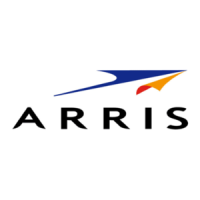Chapter 16: Dynamic Routing Protocols
STANDARD Revision 1.0 C4® CMTS Release 8.3 User Guide
© 2016 ARRIS Enterprises LLC. All Rights Reserved. 551
Set IP Recursive Next Hop
The configure route-map-policy * permit * set ip recursive-next-hop command permits the configuration of a
recursive next-hop IP address that is used in conjunction with PBR. The recursive next-hop IP address that is specified is
used as the Destination IP Address (DIP) to perform a route lookup to resolve the next-hop address. For an illustration see
the flowchart in the figure above.
The C4/c CMTS uses this IP address as the DIP instead of the DIP in the packet to forward the packet.
The following items apply to the configuration of the recursive next hop feature:
The configuration of IP recursive next-hop and IP next-hop are mutually exclusive. An attempt to configure both in the
same route map will be rejected.
The specified recursive-next-hop IP address can be any valid routable, unicast IP address that is not a C4/c CMTS
interface address.
A command configuration attempt to assign a C4/c CMTS interface address as a recursive-next-hop IP address causes
the command to be rejected as explained in the accompanying failure message.
The IP address does not have to be directly connected, and feature performance is actually optimal when the IP
address is not directly connected, because this allows normal ECMP and normal redundancy to be used to route the
packet.
If the recursive next-hop route lookup is successful:
The packet is sent using the new IP address as the DIP in the route table lookup. Note that the DIP in the packet is not
changed.
If the subnet is directly connected, the ARP entry of the recursive next-hop is used (or learned, then used).
If the subnet is remote (not directly connected), one of the ECMP route next-hop ARP entries is used (or learned, then
used).
If the C4/c CMTS fails to find a route using the recursive next hop IP, the packet is dropped and an ICMP network
"unreachable" message is sent back to the sender.
Set IP Interface Null 0
The set IP interface null 0 command is a way to drop packets. By routing undesired packets to the null interface, the C4/c
CMTS drops them and prevents them from going to a default route and possibly causing a routing loop.

